Items
Site
The Medicine Chest
keywords is exactly
collection
-
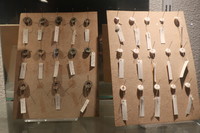
Buttons
A display of a collection of pins, buckles and buttons excavated from the washing pools used by slaves on Table Mountain. Taken from their dusty boxes in storage they are currently exhibited as part of Skotnes's 'Division of the World' (Department of Archaeology). -

Division of the World
"Undergraduate students regularly engage in discussions around certain displays as part of their teaching programme (N. Zachariou, personal communication, 27 May 2020), and the installation is also used to introduce visitors (exchange students and school children, for example) or students from other UCT departments (architecture students taking the archaeology module) to the department and the discipline (J. Parkington, personal communication, 20 June 2020). It has even been described as a ‘super curriculum’ (or as ‘several super curriculums’) for how it visualises what archaeology does on both an empirical and procedural level (J. Parkington, personal communication, 20 June 2020)" (Liebenberg 2021: 210). -
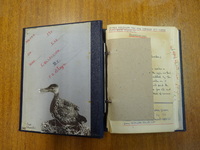
Diary of an oologist
"In 2019, Honours in Curatorship student Nathalie Viruly, who completed her Bachelor of Social Science in Politics and Sociology, was similarly struck by the silence and loss evoked by the [Peter Steyn] collection. Viruly honed in on the moments documented in the notebooks, which capture the loss of life in the reproductive life of these birds and reveal ‘stories of avian tragedy’: Young taken by predator; 1 young accidentally killed; 2 eggs failed to hatch; 2 infertile; Chick disappeared without a trace; Eggs disappeared; Literally cooked by the [corrugated] roof; Nest empty – egg collectors? (Viruly 2018: online). Her focus on these moments in the scientific journal poignantly reveals the conflation between science and emotion and invites the viewer to re-examine hierarchies of loss" (Liebenberg 2021: 219). -
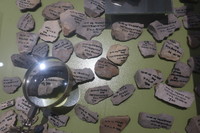
Stone tools
"By positioning artefacts to emphasise their labelling (stones are positioned to reveal the details written on them), including seemingly familiar objects and expanding and shrinking timelines, the installation [Division of the World] draws attention to the framing devices, tools and methods of the department’s insiders" (Liebenberg 2021: 207). -
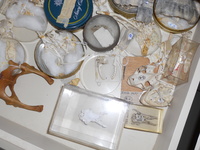
Things zoological insiders look at
A sample box of archaeological specimens shown to first year students. -
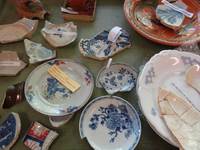
Things archaeological insiders look at
A variety of pottery shards of Asian porcelain, European earthenware and British stoneware in a drawer in the Department of Archaeology, UCT. -
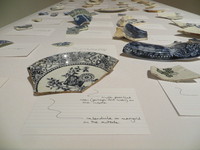
Appendix (installation shot)
A variety of pottery shards consisting of Asian porcelain, European earthenware and British stoneware sourced from the University of Cape Town Archaeology department and subjected to a botanical analysis by a graduate of the Biological Science (Botany) Department. -
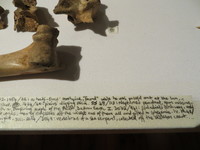
Appendix (installation shot)
A variety of bones sourced from the University of Cape Town Archaeology and Zoology departments, playfully re-imagined by the students as a collection owned by a time-travelling anthropologist - collecting samples across time and sometimes, across dimensions. -

Kimberlite
A display outside the Cape Town Diamond Museum in the V&A Waterfront -

Kimberlite
Kimberlite specimens, UCT Mantle Room -

Kimberlite
Kimberlite specimen, UCT Mantle Room -

The Diamond Mines of South Africa: Some Account of their Rise and Development.
“In the mines operated by the De Beers Company alone, more than eleven thousand African natives are employed below and above ground, coming from the Transvaal, Basutoland, and Bechuanaland, from districts far north of the Limpopo and the Zambesi, and from the Cape Colony on the east and the south to meet the swarms flocking from Delagoa Bay and countries along the coast of the Indian Ocean, while a few cross the continent from Damaraland and Namaqualand, and the coast washed by the Atlantic. The larger number are roughly classed as Basutos, Shanganes, M'umbanes, and Zulus, but there are many Batlapins from Bechuanaland, Amafengu, and a sprinkling of nearly every other tribe in South Africa” (Williams 1902: 412-413). -

The Diamond Mines of South Africa: Some Account of their Rise and Development.
“The initial impetus for establishing a collection of mantle materials for research purposes in South Africa was provided by Gardner Williams and his son Alpheus Williams in the late 19th and early 20th century. These two American mining engineers shared a great interest in the mining methods and geology of the South African kimberlite-hosted diamond mines they were supervising. Each wrote books on the subject and the two men assembled a collection of scientifically interesting rock samples and minerals from the mines. Subsequent to the death of Alpheus Williams, the Williams family donated this collection to the Geology Department at UCT for teaching and research purposes” (Department of Geological Sciences 2021). -

Notebooks 2 – Nest Records
"'Notebook 2 – Nest Records' is part of the Peter Steyn Collection at the Percy Fitzpatrick Institute of African Ornithology (PFIAO) at the University of Cape Town. It resides in the top drawer of a wooden cabinet that is locked and stained with nepheline. The drawer is shared with two other notebooks created by Steyn, the first from his youth, and the latter is focused on birds of prey. It lies beside a copy of Frank B. Smithe’s Naturalist’s Color Guide, a published article by Steyn, two printed documents, attached letters and an envelope of reference photographs. The subsequent drawers are filled with an array of labelled, blown, eggs. Pink. Blue. Burnt-copper. Speckled. Splattered" (Viruly 2019). -

Prrrip-Prrrip, Tseeeep!: the silence of birds’ eggs
"Birds are highly vocal creatures, their songs sound everyday in almost every habitat, even our concrete cities. These calls have been likened to the human capacity for speech, yet the faculty of language has, for most of history, been described as solely ‘human.’ Language forms one of several traits deployed to uphold the constructed divide between human and non-human animals. Oology – the collecting and documenting of wild bird eggs – was an obscure hobby and ‘science’ of the past. Collected eggs were pierced and ‘blown’ of their contents. The perfect shells, beautifully coloured with speckles and intricate patterns, were then placed in vast cabinet collections. Such a birds’ egg collection, collected in Southern Africa during the last half of the 20th century, forms the starting point of this exhibition. Through exploring language and communication in birds, this exhibition aims to create an affective environment for re-evaluating the collecting practices of the past (with its ties to the Euro-Western, human-centered perspective), and for re-imagining current natural history collections. It also aims to … poo-too-eee poo-too-eee, pa-chip-chip-chip per chick-a-ree. Ka-ha, ka-ha, kuh-uk-uk-uk! caw-caw-caw-caw-koodle-yah, loooooo-eee! Pa-chip-chip-chip, per-chick-a-ree!" Wall text of exhibition, Prrrip-Prrrip, Tseeeep!: the silence of birds’ eggs -
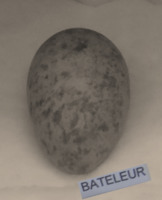
Bataleur egg
Situated in a locked bespoke cabinet in the Niven Library in UCT’s Percy Fitzgerald Institute of African Ornithology, this Bataleur eagle egg is part of a collection of eggs donated by the ornithologist Peter Steyn in 2007. Collected between 1961 and 1977, when Steyn spent time in Zimbabwe, the egg is a link to the iconic stone carved Zimbabwe Birds which once stood proudly on guard atop the walls and monoliths of the ancient city of Great Zimbabwe, believed to be built between the 12th and 15th centuries by ancestors of the Shona. The overall shape of the birds suggests that of a bateleur eagle – a bird of great significance in Shona culture. The bateleur or chapungu is a good omen, the symbol of a protective spirit and a messenger of the gods. -

Igemfe
"The transverse flute is rarely seen among the Zulu, who, if they make and use it, call it igemfe, the name of a totally different instrument. I possess three specimens, one from Inchanga, one from Pietermaritzburg district, and one from Ixopo. The first two are open at the end opposite the embouchure, and have three finger-holes; the third is a curiously aberrant example, being closed at both ends and having four finger–holes arranged in pairs" (Kirby 2013: 179) Hornbostel-Sachs number: 421.121.32 Stopped side-blown flutes with fingerholes, Length: 291mm (11.4in), Diameter: 36mm (1.2in), Place of production: St. Michael's-on-Sea (KwaZulu-Natal, South Africa).


